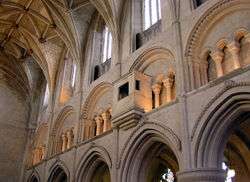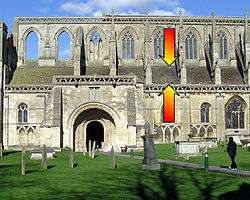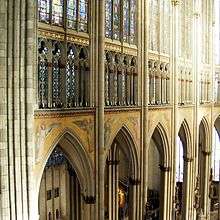Triforium
 Malmesbury Abbey, Malmesbury, Wiltshire, England showing the triforium, with its rounded arches and chevron mouldings, each arch supported by four small arches on columns. |
 Malmesbury Abbey, showing the location of the triforium. It lies between the lower (aisle) windows and the upper (clerestory) windows, as arrowed |
A triforium is a shallow arched gallery within the thickness of an inner wall, above the nave of a church or cathedral. It may occur at the level of the clerestory windows, or it may be located as a separate level below the clerestory. It may itself have an outer wall of glass rather than stone. Triforia are sometimes referred to, erroneously, as tribunes. Also called a "blind-storey", the triforium looks like a row of window frames without window openings.
History
The origin of the term is unknown but may be derived from Latin trans, "through," and foratum, "bored, drilled, cut," as it was a hollow passageway from one end of the building to the other, as suggested by the Trésor de la langue française. A derivation from Latin tres, three, and foris, door, entrance, might also be possible as in this passage the thoroughfares and doors were often in triangle shape as can be imagined from the triangular shape of this area, although the Lewis and Short Latin dictionary does not quote these words in combination, only separately. The triangle shape comes from the sloping roof, as can be seen in the picture on the right between the two arrows.
The earliest examples of triforia are those in the pagan basilicas, where a triforium constituted an upper gallery for conversation and business; in the early Christian basilicas such a passageway was usually reserved for women, and the same applied to those in the Eastern Orthodox Church.

In Romanesque and Gothic buildings it is either a spacious gallery over the side aisles or is reduced to a simple passage in the thickness of the walls; in either case it forms an important architectural division in the nave of the cathedral or church, and being of less height gives more importance to the ground storey or nave arcade. In consequence of its lesser height its bay was usually divided into two arches, which were again subdivided into two smaller arches and these subdivisions increased the apparent scale of the aisle belowe and the clerestory above.
On account of the richness of its mouldings and carved ornament in the sculpture introduced in the spandrels, it became the most highly decorated feature of the interior, the triforium at Lincoln being one of the most beautiful compositions of Gothic architecture. Even when reduced to a simple passage it was always a highly enriched feature. In the 15th-century churches in England, when the roof over the aisles was comparatively flat, more height being required for the clerestory windows, the triforium was dispensed with altogether. In the great cathedrals and abbeys the triforium was often occupied by persons who came to witness various ceremonies, and in early days was probably utilized by the monks and clergy for work connected with the church.
The triforium sometimes served structural functions, as under its roof are arches and vaults which carry thrust from the nave to the outer wall. When the flying buttress was frankly adopted by the Gothic architect and emphasized by its architectural design as an important feature, other cross arches were introduced under the roof to strengthen it.

See also
References
 This article incorporates text from a publication now in the public domain: Chisholm, Hugh, ed. (1911). "article name needed". Encyclopædia Britannica (11th ed.). Cambridge University Press.
This article incorporates text from a publication now in the public domain: Chisholm, Hugh, ed. (1911). "article name needed". Encyclopædia Britannica (11th ed.). Cambridge University Press.
External links
| Wikimedia Commons has media related to Triforia. |